Contents
Introduction
Biomedical Instrumentation deals with the measurement and analysis of current or voltage signals from different parts of the body. The human body generates a variety of voltages which are usually very small. Biomedical instrumentation helps medical personnel or physicians to make a better diagnose of the problem in a patient and provide the appropriate treatment.
The Basic Features of a Biomedical Instrumentation System
Certain characteristics, which are common in most instrumentation systems are also applied in Biomedical Instrumentation Systems. Any medical instrumentation system would be made up of the following key components:
- Measurand
- Transducer or sensor
- Signal Conditioner
- Display system

Measurand
This is the physical quantity or condition that the instrumentation system measures. The source of the Measurand is the human body which generates a variety of signals. The Measurand for example can be on the surface of the body (electrocardiogram potential) or may be blood pressure in the chambers of the heart.
Transducer/Sensor
A transducer is a device that converts one form of energy to another. A transducer converts a physical signal into an electrical output. The primary function of the transducer is to provide a usable output in a response to the Measurand. Sometimes another term, ‘’sensor’’ maybe used in medical instrumentation systems. When used here it does the same function of converting the physical Measurand to an electrical signal.
Signal Conditioner
The signal conditioner converts the output of the transducer into an electrical quantity that is suitable for operation of the display or recording system. Signal conditioning usually include functions such as amplifications, filtering, analog-to-digital conversions, digital-to-analog conversions etc. This component of the medical instrumentation system helps in increasing the sensitivity of instruments by amplification of the original signal (which is usually extremely small) or its transduced form.
Display System
This provides a visible representation of the quantity as a displacement on a scale or on the chart of a recorder the screen of CRT or in a numerical form. Besides the display unit, the processed signal after signal conditioning maybe passed to:
Alarm system: With upper and lower adjustable thresholds to indicate when the measurand physical variable goes beyond the preset limits.
Data Storage: To keep data for future reference, this may be a hard copy on a paper or on magnetic or semiconductor memories.
Data transmission: Using standard interface connections so that information obtained may be carried to other parts of an integrated system or transmits it from one location to another.


5 thoughts on “The Introduction to Biomedical Instrumentation”